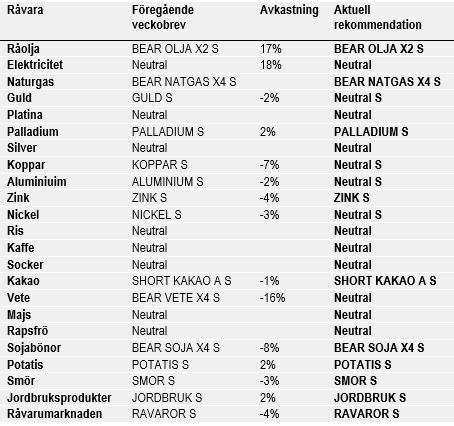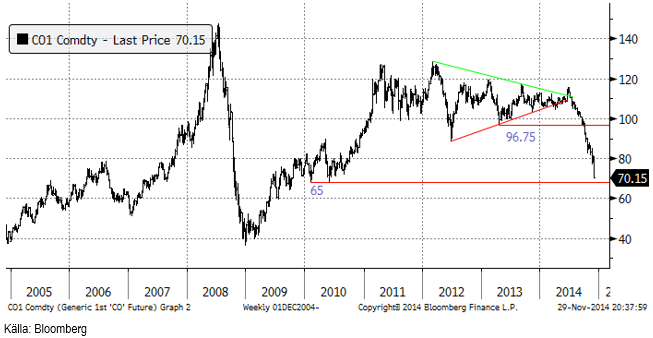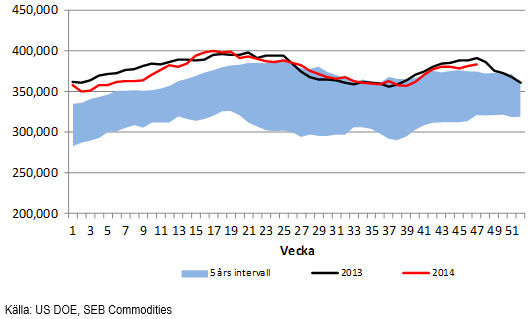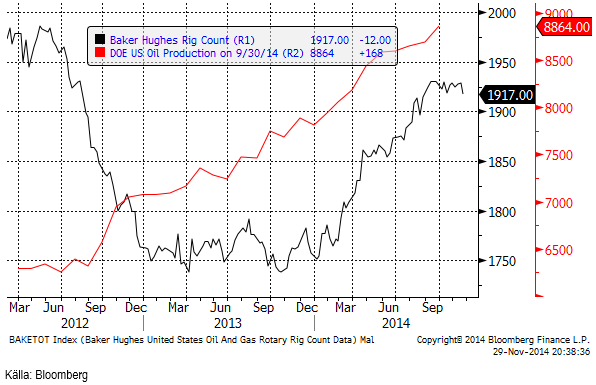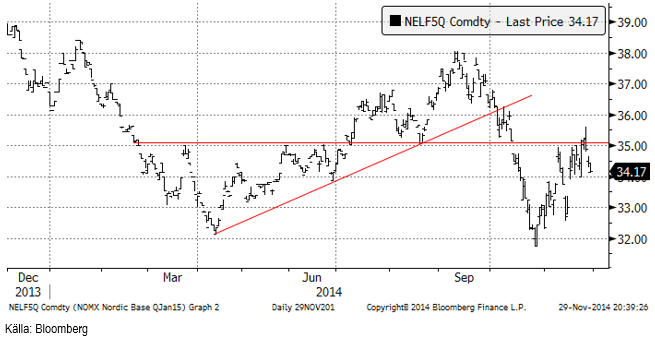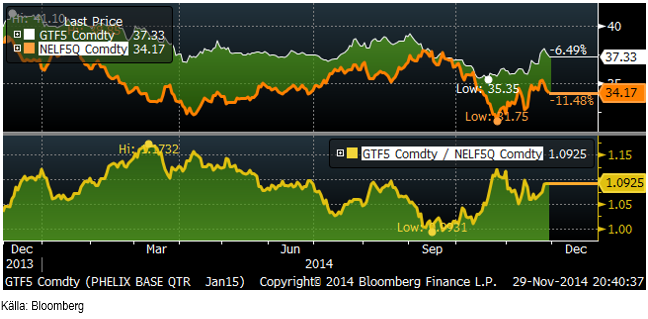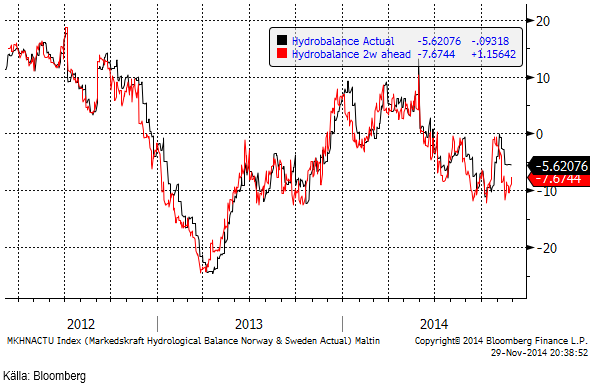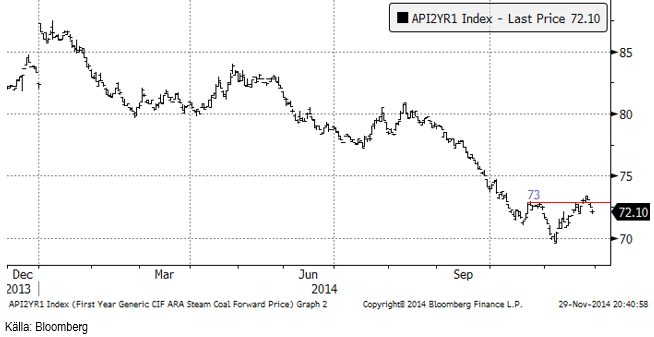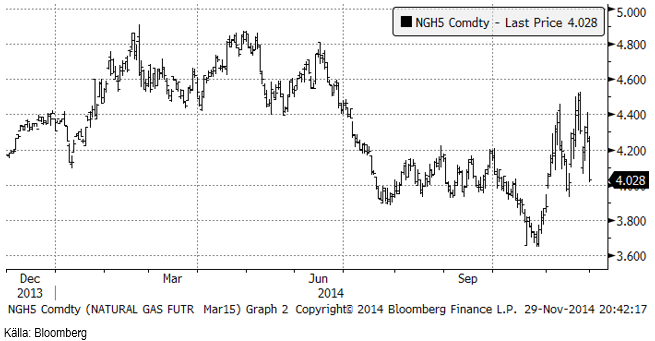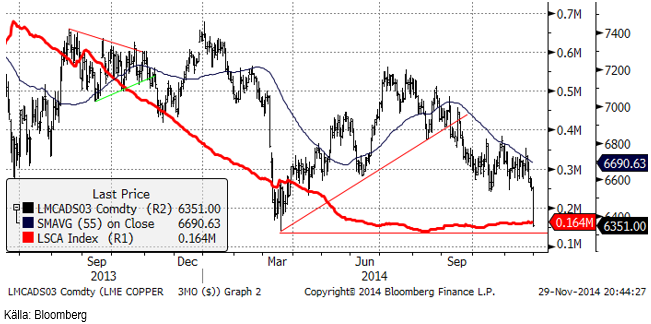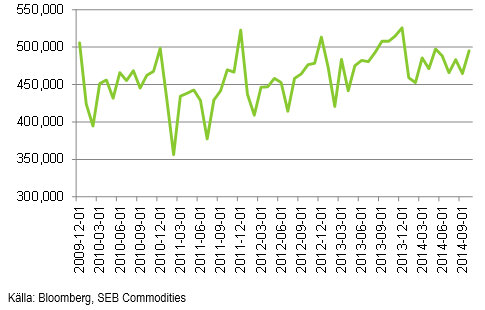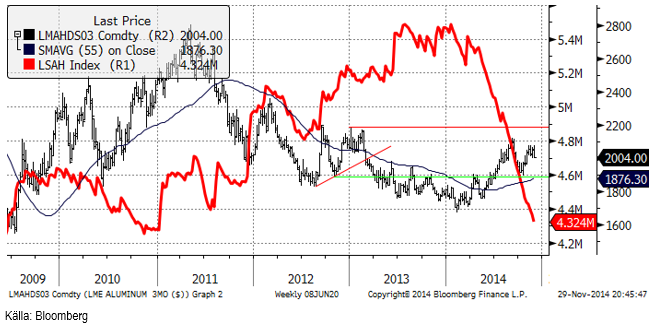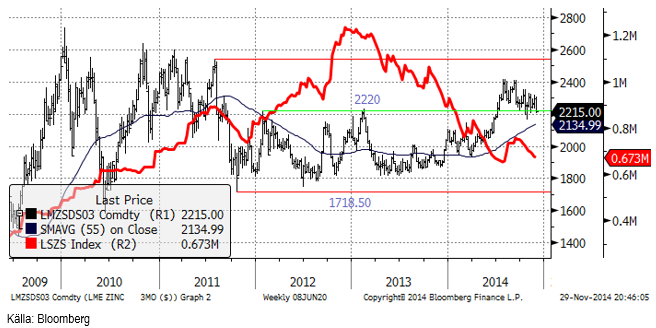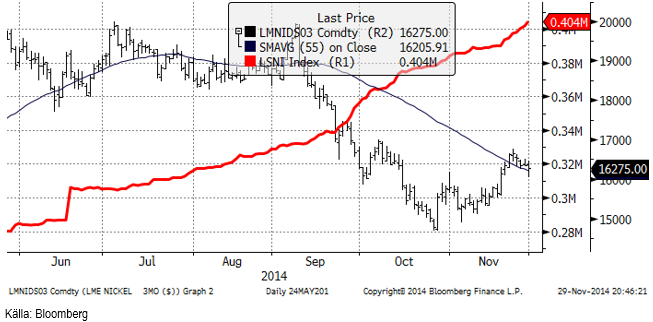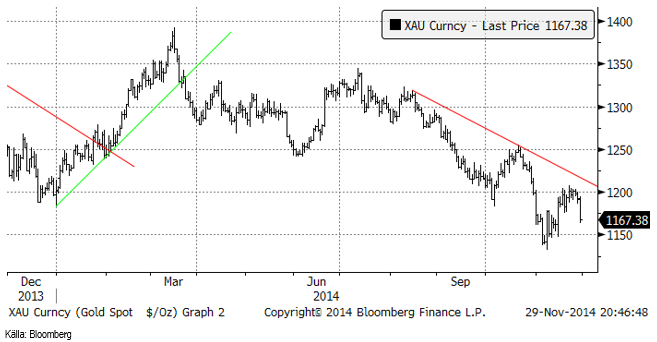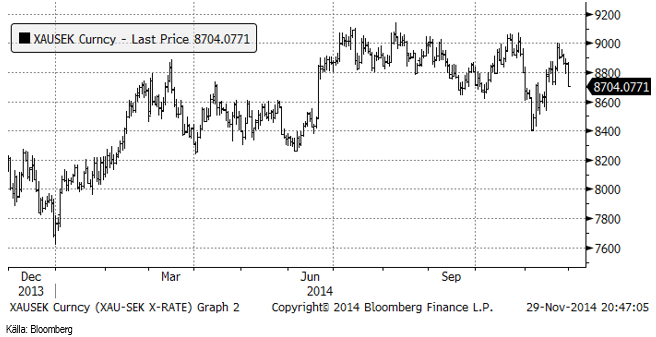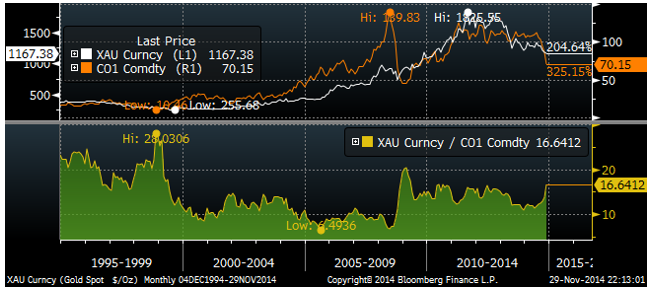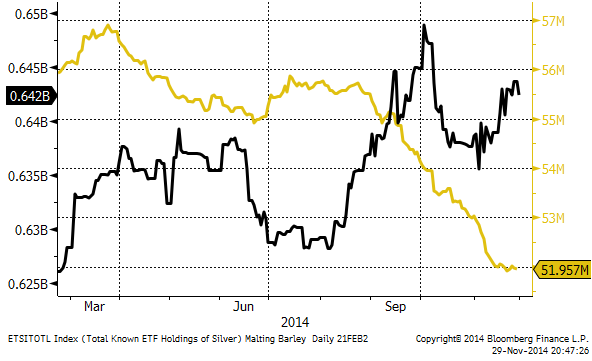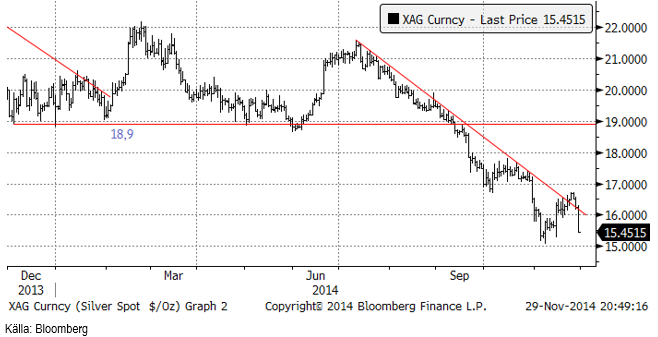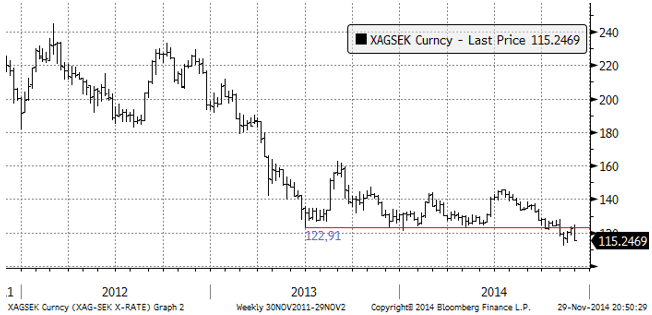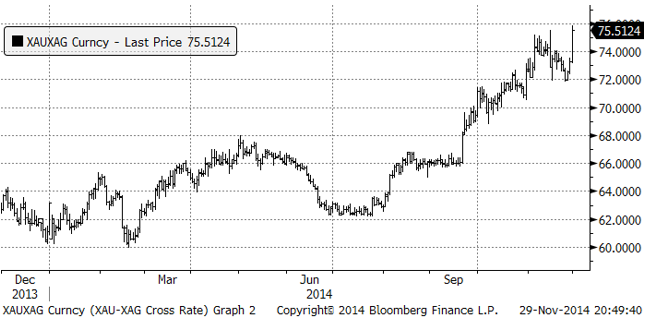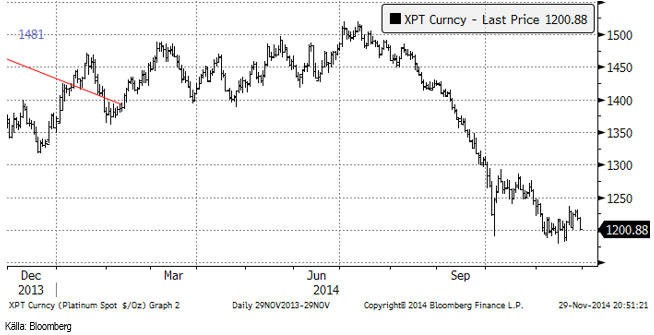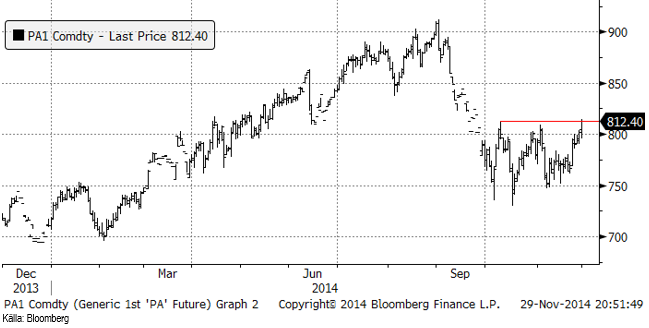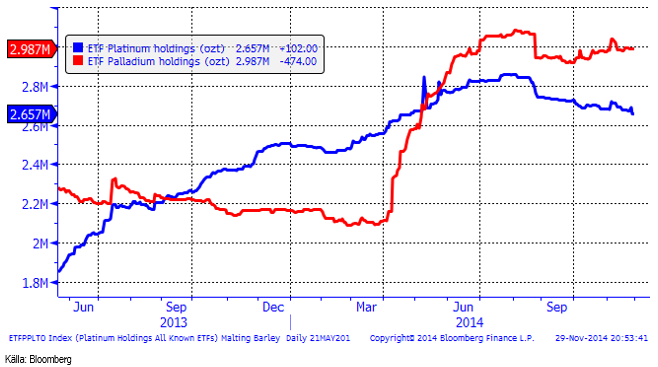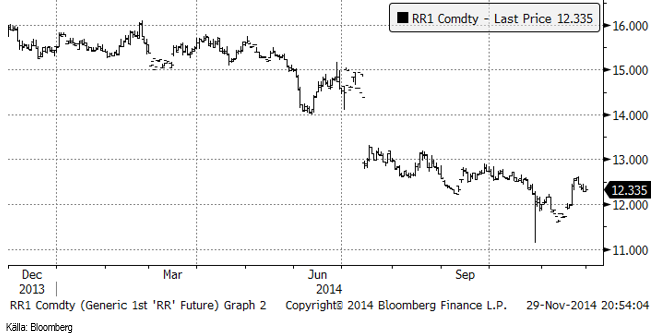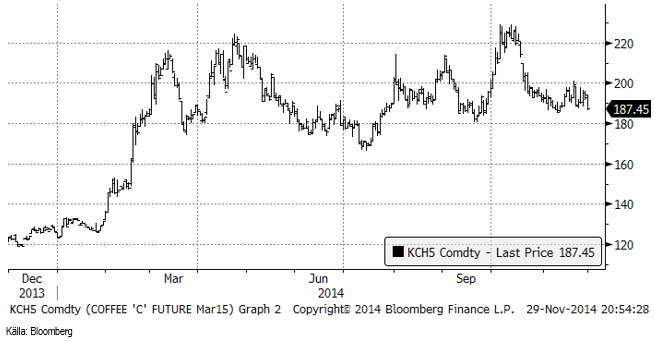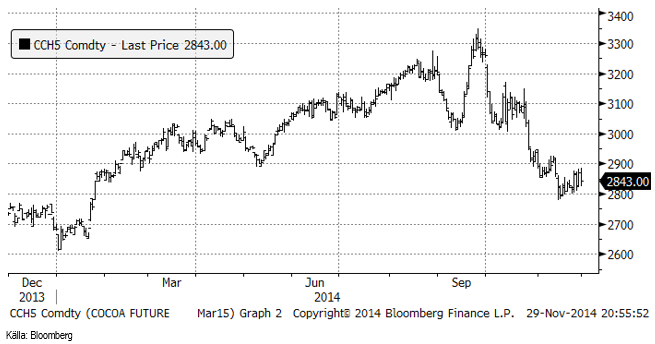Analys
SEB – Råvarukommentarer, 1 december 2014

Veckans rekommendationer
Råolja – Brent
OPEC beslutade sig för att inte ändra produktionsmålet på 30 mbpd, vilket läsare av det här veckobrevet inte bör ha blivit förvånade över. Medan det har funnits beskrivningar av beslutet som en blivande seger mot den amerikanska skifferrevolutionen, anser vi att det handlar mer om en klassisk pyrrhusseger.
Som vi har skrivit förut, beror det höga oljepriset på att det är ganska få länder som sitter på lejonparten av konventionella oljefyndigheter. Dessa har över tiden kunnat höja produktionsskatterna, ett bra exempel på economic rent. Skifferfyndigheterna är betydligt mer spridda i världen, vilket gör att föutsättningarna för att tillskansa sig en economic rent försvinner i samma takt som skiffertekniken sprider sig. Sammanhållningen inom OPEC bygger på att var och en håller igen sin produktion till det gemensamma bästa. Den som har fuskat har straffats, framförallt av Saudiarabien, eftersom Saudiarabien haft lediga produktionsresurser. Systemet håller inte när en främmande teknik fått systemet brista och förlora sin mening. Med insikten att det långsiktiga priset är väsentligt lägre, innebär det endast en förlust, utan vinst genom upprätthållande av kartellen, att hålla igen produktionen. Det innebär inte att skifferproducenterna är opåverkade, det är de inte. Men bara det faktum att tekniken finns, gör att OPEC har spelat ut sin roll.
Skiffertekniken är en ung teknik och den utvecklas med ca 30% per år. Nyligen rapporterades att fracking genomförts utan vatten. Istället användes gas, som också återvanns till 100% efter att tryckningen var klar. Invändningen att fracking begränsas pga vattenbrist på många ställen där skifferresurser finns, är alltså borta sedan förra veckan. Det gör att t ex Kina kan börja utvinna sina enorma resurser av skifferolja och skiffergas.
Lagren i USA ökade med 2 miljoner fat enligt DOE:s statistik i veckan.
Nedan ser vi ett diagram på antalet oljeriggar i USA, enligt Baker Hughes statistik (svart). Antalet riggar i drift ökade minskade med 12 till 1917. Det ser ut som om det fallande oljepriset haft en effekt på entusiasmen att borra fler oljekällor i USA.
Vi rekommenderar en kort position, t ex med BEAR OLJA X2 S.
Elektricitet
Priset på elektricitet föll mot slutet av veckan på den nordiska elbörsen Nasdaq Commodities. Varmare och blötare väder kom in i prognosfönstret.
Nedan ser vi kvoten mellan priset på terminen för tysk el under första kvartalet och terminen för nordisk el för samma kvartal. Tysk el har inte fallit i pris på samma sätt under hösten som nordisk el har gjort, utan snarare gått upp något lite.
Hydrologisk balans har enligt 2-veckors prognosen stigit med 1 TWh.
Nedan ser vi terminskontraktet för leverans av kol under 2015, som sjunkit från 72.55 dollar per ton till 72.10 i fredags. Tendensen var svag när handeln stängde för veckan.
Priset på utsläppsrätter steg i veckan från 7 till 7.04, men var uppe på 7.14 som högst.
Naturgas
Naturgaspriset föll kraftigt i fredags i samband med det stora prisfallet på råolja.
Koppar
Priset på koppar föll kraftigt i fredags. Dels påverkade prisfallet på olja negativt. Priset på olja (energi) är en stor del av produktionskostnaden för koppar. Dels visade ny statistik från Chile att produktionen i landet inte minskar, utan istället låg på den högsta nivån på fem månader under oktober.
Chile rapporterade i fredags att landets kopparproduktion uppgick till 495,248 ton i oktober. Det är den högsta nivån på fem månader och visar inga tecken på att reagera på ett lägre kopparpris.
Som vi ser i kursdiagrammet har 3-månadersterminen ännu inte brutit golvet vid 6300 dollar per ton. På COMEX handlas dock koppar lägre än den lägsta noteringen i mars månad, vilket kan utlösa ytterligare prisfall. Vi väljer därför att gå över till neutral rekommendation.
Aluminium
Aluminiumpriset var förbluffande stabilt i veckan, trots att energi är en så stor del av produktionskostnaden och priset på olja föll så kraftigt. Vi tror inte att prisfallet på olja kommer att gå helt obemärkt förbi och väljer därför att gå över till neutral rekommendation.
Zink
Zink föll också pga det lägre oljepriset. Tekniskt har marknaden stöd precis där priset ligger och lagernivån fortsätter att sjunka vid LME. Därför behåller vi köprekommendationen på ZINK S.
Nickel
Nickelpriset föll lav ganska kraftigt i veckan. Nickel används mycket i olje- och gasindustrin. Man kan tänka sig att olje- och gasindustrin i USA går in i ett lite lugnare skede efter oljeprisfallet och det bör tynga nickelpriset. Lagernivån vid LME fortsätter också att stiga, vilket gör att marknaden är känslig för negativa signaler. Vi väljer därför att gå över till neutral rekommendation på nickel.
Guld
Guldpriset lyckades inte bryta 1200 dollar, en psykologiskt viktig nivå eftersom produktionskostnaden för många gruvbolag ligger ungefär där, som marknaden uppfattar genomsnittet för kostnaderna.
I Schweiz folkomröstning att återställa guldreserven i söndags blev det ett rungande ”nej”. Det var i och för sig väntat, men beskedet kan ändå tynga guldpriset lite ytterligare i veckan.
Chartet för guld i kronor visar också fallande pris på veckan.
Prisfallet på olja och det viktiga beslut som (inte) fattades vid OPEC-mötet, fick guldpriset att falla ytterligare. Det finns två anledningar till varför med anledning av oljepriset. För det första ger ett lägre oljepris en kraftig boost för ekonomierna i Tyskland, Frankrike och USA. Det är länder som använder olja för att tillverka andra varor och sälja dem. Vinsterna stiger i näringslivet i dessa länder och det minskar risken för att via inflation behöva inflatera bort skulder. För det andra är kostnaden för olja och annan energi en betydande andel av kostnaden för att producera guld i gruvdrift. Det är djupa gruvor och det är låga halter med mycket malm att krossa för att få fram metallen.
Vi ser kvoten mellan guld och olja nedan. Relationen har alltså stigit ganska kraftigt den senaste tiden och ligger i ett historiskt perspektiv ganska högt. Ytterligare oljeprisfall borde därför dra med sig guldpriset nedåt.
Institutionella investerare äger via ETF/ETC-er 51.96 miljoner uns guld och det är faktiskt mer än de gjorde för en vecka sedan, när de ägde 51.91 miljoner uns. Däremot har de faktiskt netto sålt lite silver.
Vi väljer att gå över till neutral rekommendation på guld.
Silver
Silverpriset vände ner, precis där det i priset i kronor fanns ett starkt motstånd. Vi skrev om det som ett säljtillfälle förra veckan. Silverpriset kommer antagligen att falla ner till en ny årslägsta notering.
Silverpriset i kronor som vi nämnde ovan, vände ner precis vid motståndslinjen. En ny bottennotering är trolig.
Silver nådde en ny bottennivå i relation till guld. Priset på guld i silvertermer nådde med andra ord en ny toppnivå.
Platina & Palladium
Platina föll, liksom guld och silver kraftigt i veckan, ner till 1200 dollar, som för platina fortfarande är en teknisk stödnivå.
Palladiumpriset har stigit från 794.90 för en vecka sedan till 812.40 dollar per uns. Marknaden stängde precis på motståndet, som måste brytas för att marknaden ska få signalen att nästa nivå att testa är 900 dollar. Palladiummarknaden har ett mycket mer positivt beteende än guld, silver och platina och det är inte omöjligt att priset på palladium kan gå upp samtidigt som de andra faller.
Nedanför ser vi hur mycket metall som finns i börshandlade fonder för platina respektive palladium. Investerare har sålt platina och köpt palladium den senaste veckan.
Ris
Priset på ris sjönk i veckan till 12.335 cent per pund.
Kaffe
Kaffepriset (mars) har backat med ett par cent sedan förra veckan. Den brasilianska valutan försvagades i spåren av oljeprisfallet. Djuphavsoljan som varit Brasiliens stora hopp, kostar ca 90 dollar per fat att få upp från 3 km djup under havsytan och den är värdelös vid dagens prisnivå – och den prisnivå som troligen kommer att råda under överskådlig framtid.
Det regnar som vi sett ovan, ganska rikligt över kaffeodlingsområdena i Brasilien. Även detta tynger priset på kaffe.
Vi tror inte att priset går upp. Frågan är när priset börjar falla. Än så länge avvaktar vi med en neutral rekommendation.
Kakao
Kakaopriset rörde sig upp och ner ganska volatilt i veckan. Skörden börjar komma igång. International Cocoa Organization (ICCO) rapporterade i fredags att de väntar sig att överskottet i år blir ännu större än de trott tidigare. Fram till i somras trodde de att skörden skulle bli mindre än konsumtionen. Då ändrade de sig och trodde på ett överskott på 40,000 ton. I fredags justerade de upp överskottet till 53,000 ton.
ICCO estimerar produktionen till 4.37 mt, en höjning från tidigare estimatet 4.35 mt. Samtidigt justerar de konsumtionen till 4.27 mt, även det en höjning från tidigare 4.26 mt.
Skörden i Elfenbenskusten är emellertid långsammare än väntat.
Vi behåller positionen i SHORT KAKAO A S. Nu finns även en BEAR KAKAO X1 S med 1 gånger negativ daglig hävstång och en BEAR KAKAO X4 S med fyra gångers negativ daglig hävstång.
För fler analyser på jordbruksråvaror se SEB jordbruksanalyser.
[box]SEB Veckobrev Veckans råvarukommentar är producerat av SEB Merchant Banking och publiceras i samarbete och med tillstånd på Råvarumarknaden.se[/box]
Disclaimer
The information in this document has been compiled by SEB Merchant Banking, a division within Skandinaviska Enskilda Banken AB (publ) (“SEB”).
Opinions contained in this report represent the bank’s present opinion only and are subject to change without notice. All information contained in this report has been compiled in good faith from sources believed to be reliable. However, no representation or warranty, expressed or implied, is made with respect to the completeness or accuracy of its contents and the information is not to be relied upon as authoritative. Anyone considering taking actions based upon the content of this document is urged to base his or her investment decisions upon such investigations as he or she deems necessary. This document is being provided as information only, and no specific actions are being solicited as a result of it; to the extent permitted by law, no liability whatsoever is accepted for any direct or consequential loss arising from use of this document or its contents.
About SEB
SEB is a public company incorporated in Stockholm, Sweden, with limited liability. It is a participant at major Nordic and other European Regulated Markets and Multilateral Trading Facilities (as well as some non-European equivalent markets) for trading in financial instruments, such as markets operated by NASDAQ OMX, NYSE Euronext, London Stock Exchange, Deutsche Börse, Swiss Exchanges, Turquoise and Chi-X. SEB is authorized and regulated by Finansinspektionen in Sweden; it is authorized and subject to limited regulation by the Financial Services Authority for the conduct of designated investment business in the UK, and is subject to the provisions of relevant regulators in all other jurisdictions where SEB conducts operations. SEB Merchant Banking. All rights reserved.
Analys
Tightening fundamentals – bullish inventories from DOE

The latest weekly report from the US DOE showed a substantial drawdown across key petroleum categories, adding more upside potential to the fundamental picture.

Commercial crude inventories (excl. SPR) fell by 5.8 million barrels, bringing total inventories down to 415.1 million barrels. Now sitting 11% below the five-year seasonal norm and placed in the lowest 2015-2022 range (see picture below).
Product inventories also tightened further last week. Gasoline inventories declined by 2.1 million barrels, with reductions seen in both finished gasoline and blending components. Current gasoline levels are about 3% below the five-year average for this time of year.
Among products, the most notable move came in diesel, where inventories dropped by almost 4.1 million barrels, deepening the deficit to around 20% below seasonal norms – continuing to underscore the persistent supply tightness in diesel markets.
The only area of inventory growth was in propane/propylene, which posted a significant 5.1-million-barrel build and now stands 9% above the five-year average.
Total commercial petroleum inventories (crude plus refined products) declined by 4.2 million barrels on the week, reinforcing the overall tightening of US crude and products.


Analys
Bombs to ”ceasefire” in hours – Brent below $70

A classic case of “buy the rumor, sell the news” played out in oil markets, as Brent crude has dropped sharply – down nearly USD 10 per barrel since yesterday evening – following Iran’s retaliatory strike on a U.S. air base in Qatar. The immediate reaction was: “That was it?” The strike followed a carefully calibrated, non-escalatory playbook, avoiding direct threats to energy infrastructure or disruption of shipping through the Strait of Hormuz – thus calming worst-case fears.

After Monday morning’s sharp spike to USD 81.4 per barrel, triggered by the U.S. bombing of Iranian nuclear facilities, oil prices drifted sideways in anticipation of a potential Iranian response. That response came with advance warning and caused limited physical damage. Early this morning, both the U.S. President and Iranian state media announced a ceasefire, effectively placing a lid on the immediate conflict risk – at least for now.
As a result, Brent crude has now fallen by a total of USD 12 from Monday’s peak, currently trading around USD 69 per barrel.
Looking beyond geopolitics, the market will now shift its focus to the upcoming OPEC+ meeting in early July. Saudi Arabia’s decision to increase output earlier this year – despite falling prices – has drawn renewed attention considering recent developments. Some suggest this was a response to U.S. pressure to offset potential Iranian supply losses.
However, consensus is that the move was driven more by internal OPEC+ dynamics. After years of curbing production to support prices, Riyadh had grown frustrated with quota-busting by several members (notably Kazakhstan). With Saudi Arabia cutting up to 2 million barrels per day – roughly 2% of global supply – returns were diminishing, and the risk of losing market share was rising. The production increase is widely seen as an effort to reassert leadership and restore discipline within the group.
That said, the FT recently stated that, the Saudis remain wary of past missteps. In 2018, Riyadh ramped up output at Trump’s request ahead of Iran sanctions, only to see prices collapse when the U.S. granted broad waivers – triggering oversupply. Officials have reportedly made it clear they don’t intend to repeat that mistake.
The recent visit by President Trump to Saudi Arabia, which included agreements on AI, defense, and nuclear cooperation, suggests a broader strategic alignment. This has fueled speculation about a quiet “pump-for-politics” deal behind recent production moves.
Looking ahead, oil prices have now retraced the entire rally sparked by the June 13 Israel–Iran escalation. This retreat provides more political and policy space for both the U.S. and Saudi Arabia. Specifically, it makes it easier for Riyadh to scale back its three recent production hikes of 411,000 barrels each, potentially returning to more moderate increases of 137,000 barrels for August and September.
In short: with no major loss of Iranian supply to the market, OPEC+ – led by Saudi Arabia – no longer needs to compensate for a disruption that hasn’t materialized, especially not to please the U.S. at the cost of its own market strategy. As the Saudis themselves have signaled, they are unlikely to repeat previous mistakes.
Conclusion: With Brent now in the high USD 60s, buying oil looks fundamentally justified. The geopolitical premium has deflated, but tensions between Israel and Iran remain unresolved – and the risk of missteps and renewed escalation still lingers. In fact, even this morning, reports have emerged of renewed missile fire despite the declared “truce.” The path forward may be calmer – but it is far from stable.
Analys
A muted price reaction. Market looks relaxed, but it is still on edge waiting for what Iran will do

Brent crossed the 80-line this morning but quickly fell back assigning limited probability for Iran choosing to close the Strait of Hormuz. Brent traded in a range of USD 70.56 – 79.04/b last week as the market fluctuated between ”Iran wants a deal” and ”US is about to attack Iran”. At the end of the week though, Donald Trump managed to convince markets (and probably also Iran) that he would make a decision within two weeks. I.e. no imminent attack. Previously when when he has talked about ”making a decision within two weeks” he has often ended up doing nothing in the end. The oil market relaxed as a result and the week ended at USD 77.01/b which is just USD 6/b above the year to date average of USD 71/b.

Brent jumped to USD 81.4/b this morning, the highest since mid-January, but then quickly fell back to a current price of USD 78.2/b which is only up 1.5% versus the close on Friday. As such the market is pricing a fairly low probability that Iran will actually close the Strait of Hormuz. Probably because it will hurt Iranian oil exports as well as the global oil market.
It was however all smoke and mirrors. Deception. The US attacked Iran on Saturday. The attack involved 125 warplanes, submarines and surface warships and 14 bunker buster bombs were dropped on Iranian nuclear sites including Fordow, Natanz and Isfahan. In response the Iranian Parliament voted in support of closing the Strait of Hormuz where some 17 mb of crude and products is transported to the global market every day plus significant volumes of LNG. This is however merely an advise to the Supreme leader Ayatollah Ali Khamenei and the Supreme National Security Council which sits with the final and actual decision.
No supply of oil is lost yet. It is about the risk of Iran closing the Strait of Hormuz or not. So far not a single drop of oil supply has been lost to the global market. The price at the moment is all about the assessed risk of loss of supply. Will Iran choose to choke of the Strait of Hormuz or not? That is the big question. It would be painful for US consumers, for Donald Trump’s voter base, for the global economy but also for Iran and its population which relies on oil exports and income from selling oil out of that Strait as well. As such it is not a no-brainer choice for Iran to close the Strait for oil exports. And looking at the il price this morning it is clear that the oil market doesn’t assign a very high probability of it happening. It is however probably well within the capability of Iran to close the Strait off with rockets, mines, air-drones and possibly sea-drones. Just look at how Ukraine has been able to control and damage the Russian Black Sea fleet.
What to do about the highly enriched uranium which has gone missing? While the US and Israel can celebrate their destruction of Iranian nuclear facilities they are also scratching their heads over what to do with the lost Iranian nuclear material. Iran had 408 kg of highly enriched uranium (IAEA). Almost weapons grade. Enough for some 10 nuclear warheads. It seems to have been transported out of Fordow before the attack this weekend.
The market is still on edge. USD 80-something/b seems sensible while we wait. The oil market reaction to this weekend’s events is very muted so far. The market is still on edge awaiting what Iran will do. Because Iran will do something. But what and when? An oil price of 80-something seems like a sensible level until something do happen.
-

 Nyheter3 veckor sedan
Nyheter3 veckor sedanStor uppsida i Lappland Guldprospekterings aktie enligt analys
-

 Nyheter4 veckor sedan
Nyheter4 veckor sedanBrookfield ska bygga ett AI-datacenter på hela 750 MW i Strängnäs
-

 Nyheter4 veckor sedan
Nyheter4 veckor sedanSommaren inleds med sol och varierande elpriser
-

 Nyheter4 veckor sedan
Nyheter4 veckor sedanOPEC+ ökar oljeproduktionen trots fallande priser
-

 Nyheter3 veckor sedan
Nyheter3 veckor sedanSilverpriset släpar efter guldets utveckling, har mer uppsida
-

 Analys4 veckor sedan
Analys4 veckor sedanBrent needs to fall to USD 58/b to make cheating unprofitable for Kazakhstan
-

 Nyheter4 veckor sedan
Nyheter4 veckor sedanTradingfirman XTX Markets bygger datacenter i finska Kajana för 1 miljard euro
-

 Nyheter2 veckor sedan
Nyheter2 veckor sedanUppgången i oljepriset planade ut under helgen


